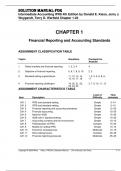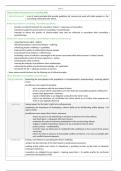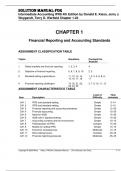zation of Securities Commissions) and the IASB (International Accounting Standards Board.) The IOSCO does not set accounting standards, but ensures that the global markets c an operate in an efficient and effective manner. Conversely, the IASB ‘s mission is to develop a single set of high quality, enforceable and global financial reporting standards (IFRSs) for general -purpose financial statements. LO: 3, Bloom: K, Difficulty: Simple, Time: 3 -5, AACSB: None, AICPA BB: None, AICPA FC: Reporting, AICPA PC: Communication 12. IOSCO (International Organization of Securities Commissions) is an association of organizations that regulate the world ‘s securities markets . Members are gene rally the main fi nancial regulators for a given country. IOSCO does not set accounting standards. LO: 3, Bloom: K, Difficulty: Simple, Time: 3 -5, AACSB: None, AICPA BB: None, AICPA FC: Reporting, AICPA PC: Communication 13. The mission of the IASB (Intern ational Accounting Standards Board) is to develop, in the public interest, a single set of high quality, enforc eable global international financial reporting standards (IFRSs) for general -purpose financial statements. LO: 3, Bloom: K, Difficulty: Simple, T ime: 3 -5, AACSB: None, AICPA BB: None, AICPA FC: Reporting, AICPA PC: Communication 14. The purpose of the Monitoring Board is to establish a link between accounting standard -setters and those public authorities ( such as IOSCO ) that generally oversee acco unting standard -setters . This board also provide s political legitimacy to the overall organization. LO: 3, Bloom: K, Difficulty: Simple, Time: 3 -5, AACSB: None, AICPA BB: None, AICPA FC: Reporting, AICPA PC: Communication 15. The IASB preliminary views ar e based on research and analysis conducted by the IASB staff. IASB exposure drafts are issued after the Board evaluates research and public response to preliminary views. IASB standards are issued after the Board evaluates responses to the exposure draft. LO: 3, Bloom: K, Difficulty: Simple, Time: 3 -5, AACSB: None, AICPA BB: None, AICPA FC: Reporting, AICPA PC: Communication 16. IASB International Financial Reporting Standards are financial accounting standards issued by the IASB and are referred to as Int ernational Financial Reporting Standards (IFRS). The IFRS Concept ual Framework for Financial Reporting sets forth fundamental objectives and concepts that the Board uses in developing future standards of financial reporting. The intent of the Conceptual Framework is to form a cohesive set of interrelated con cepts that will serve as tools for solving existing and emerging problems in a consistent manner. LO: 3, Bloom: K, Difficulty: Simple, Time: 3 -5, AACSB: None, AICPA BB: None, AICPA FC: Reporting, AICPA PC: Communication 17. In ranking from the most authoritative to least authoritative, International Financial Reporting Standards are the most authoritative, followed by International Financial Reporting Standard Interpretations and then the Conceptual Framework for Financial Reporting . LO: 3, Bloom: K, Difficulty: Simple, Time: 3 -5, AACSB: None, AICPA BB: None, AICPA FC: Reporting, AICPA PC: Communication 1-1-4 Copyright © 2020 Wiley Kieso, IFRS, 4/e, Solutions Manual (For Instructor Use Only) Questions Chapter 1 (Continued) 18. The International Financial Reporting Standard s Interpretatio ns Committee (IFRIC) applies a principles -based approach in providing interpretative guidance. The IFRIC issues interpretations that cover newly identified financial reporting issues not specifically dealt with in IFRS, and issues where conflicting interpr etations have developed, or seem likely to develop in the absence of authoritative guidance. LO: 3, Bloom: K, Difficulty: Simple, Time: 3 -5, AACSB: None, AICPA BB: None, AICPA FC: Reporting, AICPA PC: Communication 19. Some major challenges facing the acc ounting profession relate to the following items: Nonfinancial measurement —how to report significant key performance measurements such as customer satisfaction indexes, backlog information and reject rates on goods purchased. Forward -looking information —how to report more future -oriented information. Soft assets —how to report on intangible assets, such as market know -how, market dominance, and well -trained employees. Timeliness —how to report more real -time information. LO: 4, Bloom: K, Difficulty: Simp le, Time: 3 -5, AACSB: None, AICPA BB: None, AICPA FC: Reporting, AICPA PC: Communication 20. The sources of pressure are innumerable, but the most intense and continuous pressure to change or influence the development of IFRS come from individual companie s, industry associations, governmental agencies, practicing accountants, academicians, professional accounting organizations, and investing public. LO: 4, Bloom: K, Difficulty: Simple, Time: 3 -5, AACSB: None, AICPA BB: None, AICPA FC: Reporting, AICPA PC: Communication 21. Economic consequences means the impact of accounting reports on the wealth positions of issuers and users of financial information , and the decision -making behavior resulting from that impact. In other words, accounting information impac ts various users in many different ways which leads to wealth transfers among these various groups. If politics plays an important role in the development of accounting rules, the rules will be subject to manipulation for the purpose of furthering whateve r policy prevails at the moment. No matter how well intentioned the rule -maker may be, if information is designed to indicate that investing in a particular enterprise involves less risk than it actually does, or is designed to encourage invest -
ment in a p articular segment of the economy, financial reporting will suffer an irreplaceable loss of credibility. LO: 4, Bloom: K, Difficulty: Simple, Time: 3 -5, AACSB: None, AICPA BB: None, AICPA FC: Reporting, AICPA PC: Communication 22. No one particular proposa l is expected in answer to this question. The students ‘ proposals, however, should be defensible relative to the following criteria: (1) The method must be efficient, responsive, and expeditious. (2) The method must be free of bias and be above or insulate d from pressure groups. (3) The method must command widespread support if it does not have legislative authority. (4) The method must produce sound yet practical accounting principles or standards. The students ‘ proposals might take the form of alterations of the existing methodology, an accoun -
ting court (as proposed by Leonard Spacek), or governmental device. LO: 4, Bloom: K, Difficulty: Simple, Time: 3 -5, AACSB: None, AICPA BB: None, AICPA FC: Reporting, AICPA PC: Communication 23. Concern exists about fraudulent financial reporting because it can undermine the entire financial reporting process. Failure to provide information to users that is accurate can lead to inappropriate allocations of resources in our economy. In addition, failure to detect massi ve fraud can lead to additional governmental oversight of the accounting profession. LO: 4, Bloom: K, Difficulty: Simple, Time: 3 -5, AACSB: None, AICPA BB: None, AICPA FC: Reporting, AICPA PC: Communication











